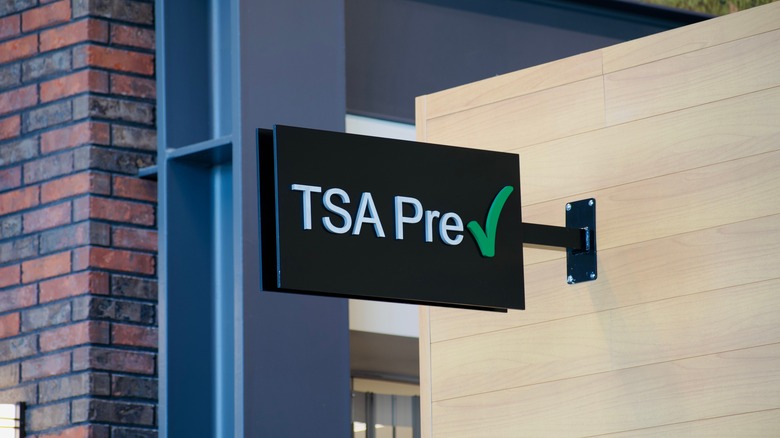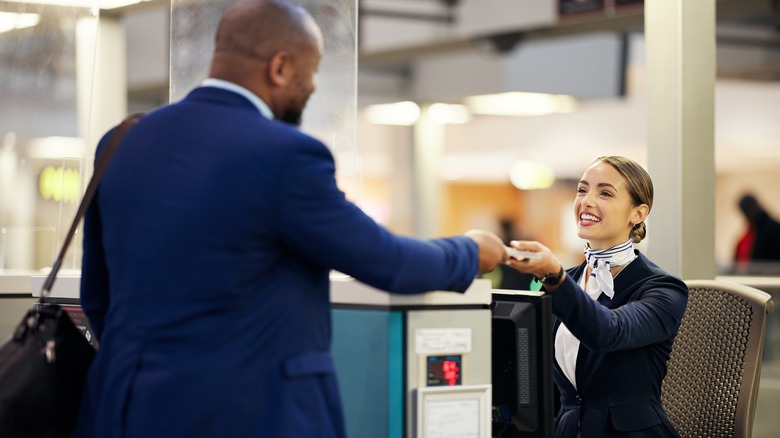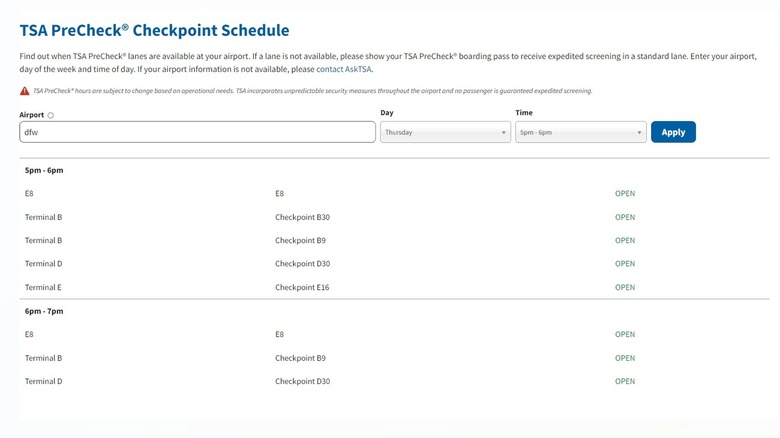How To Check If The Airport You're Heading To Will Have TSA PreCheck Lanes Open
It's a good idea to prepare for the unpredictable when you're leaving on a trip. Traffic can slow your progress to the airport, a thunderstorm can delay a flight, and crowds at the security gate can take up precious time as you try to get to your plane. Many people have discovered that using TSA PreCheck is one of the best ways to help you get through airport security faster. The TSA PreCheck lanes are reserved for those who are eligible to enroll in the program, and using one can definitely save some time. But what happens if you get to the security gate and discover that these designated lanes are closed? Fortunately, there's a way to check ahead of time to see which ones are open before you even get to the airport. By using the TSA PreCheck Checkpoint Schedule, you can eliminate this worry from your travel plans.
The TSA PreCheck Checkpoint Schedule is a resource that TSA provides on its website to help travelers know what to expect when they arrive at the security gate. TSA PreCheck is available at over 200 airports and 90 airlines, according to TSA, but it's important to note that these special lanes are not available at every gate, and they're also not open around the clock. By entering just a few key details about your travel itinerary, you'll be able to determine far in advance whether or not you can expect to use a PreCheck lane when you arrive at the security gate.
What are the benefits, and how does it work?
If you're not enrolled in the program, you may be wondering if paying for TSA PreCheck is actually worth it. TSA states that approximately 99% of PreCheck passengers spend less than 10 minutes moving through security. Children who are 17 years old and younger can also benefit from this expedited process if they travel with an adult who is enrolled, as long as TSA PreCheck is listed on the minor's boarding pass. PreCheck participants aren't required to remove their shoes, belts, or light jackets in the security lines, and they can keep their laptops and 3-1-1 liquids packed in their bags. Simplifying these security protocols can really make a difference when you've got a plane to catch. So how can you be sure that a PreCheck lane will be open the next time you go on a trip?
Begin by accessing the TSA PreCheck Checkpoint Schedule tool, and enter the name or code of your departure airport. Next, choose the day of the week when you're traveling. Finally, select the approximate time when you expect to arrive at security by choosing from a list of hour-long increments, such as 8 a.m. to 9 a.m. Click on the "Apply" button, and the system will generate a list of terminals that have PreCheck lanes open at that time. It will also list the specific gate where each lane is located. Any PreCheck lanes that are closed during that hour will not appear on the list.
Use the TSA PreCheck Checkpoint Schedule to help you plan your itinerary
You might consider using this tool before you even book your flight, as you can see in advance the times of day when more PreCheck lanes are available. For example, perhaps you'd like to go away for the weekend and leave from Dallas/Fort Worth International Airport (DFW) on a Thursday. After you've finished checking any bags, you might expect to arrive at the security gate around 5 p.m. By entering DFW into the airport field and choosing Thursday from 5 p.m to 6 p.m., you'll see that five PreCheck lanes are open across the airport at this time. The schedule also shows that three lanes are open after 6 p.m. However, if you arrive at 4 p.m., all seven lanes across the airport are open. Using this tool can save you some time and hassle by choosing the best hour to go through security.
Coordinating your travel plans with the TSA PreCheck Checkpoint Schedule can be a worthwhile step as you build your itinerary. It can help you estimate how much time it will take to move through the airport and arrive at your departure gate. In the future, you might also be able to use a self-service screening program that is making the security checkpoint even more efficient. As these types of resources are developed, travelers can begin to focus less on their experience at the airport and more on the joy of their journey ahead.


